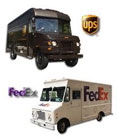Something unusual happened on Wall Street last week
Supply Chain Digest Says...
|
 |
| Interestingly, FedEx and UPS both say these discounts for smaller shippers are primarily for customers that ship boxes that align with their network strategies well. |
 |
What do you say? |
| Click here to send us your comments |
 |
| |
|
While stock prices soared overall, with the S&P 500 up 4.7% stemming from Donald Trump’s election victory, just one stock out of 23 in SCDigest’s supply chain stock market index saw negative results.
That would be UPS, down 1.2%. FedEx fared better, ending the week in positive territory, but its 16% rise in the price of its shares is less than the 37% gain in the S&P.
What’s going on? After peaking in 2021, US parcel volumes fell in both 2022 and 2023, and remained soft so far this year.
With a late Thanksgiving this year, there are five fewer days to the Christmas shopping season than in 2023, putting pressure on parcel volumes this year.
And there is Amazon. While FedEx ended its contract with Amazon a few years ago, UPS still delivers some of the company’s packages. The problem: Amazon keeps doing more of its own deliveries, up to more than two-thirds of its parcels.
The US Postal Service is also gaining share in ground parcel deliveries.
As a result, both UPS and FedEx are scrambling for customers, leading each carrier to do something not seen just a few years ago: offer attractive discounts to medium and even some smaller parcel shippers.
Both parcel giants recently lowered their revenue estimates for the current year.
“UPS and FedEx, which began offering discounts to larger customers last year, are now aggressively chasing smaller customers, giving them breaks that are typically reserved for bulk shippers,” wrote the Wall Street Journal (Esther Fung) in a recent article.
The Journal quotes Robert Persuit, an executive at shipping analytics firm ShipMatrix, as saying that “Until recently, it was unheard of for shippers with less than $500,000 in annual shipping expenses to get a break on fuel surcharges, for example, said. Now, he said, “no customer is too small to be considered for discounts."
(See More Below)
Interestingly, FedEx and UPS both say these discounts for smaller shippers are primarily for customers that ship boxes that align with their network strategies well.
 UPS told the Journal it offers discounts for parcels that travel longer distances or that originate in spots where the carrier is looking to boost productivity. UPS told the Journal it offers discounts for parcels that travel longer distances or that originate in spots where the carrier is looking to boost productivity.
FedEx noted its rates for a customer depends on many factors, including how its shipments fit into its network.
Overall, the cost to ship a parcel with ground service in the US last quarter fell 2.5%. That drop was caused by higher discounts from carriers and because the packages shipped had a lower average weight, according to AFS Logistics, a third-party logistics provider and as reported by the Journal.
“FedEx and UPS are trying to thread the needle between protecting their profit margins and boosting parcel volume,” the Journal notes.
It adds that both carriers have laid off tens of thousands of workers and closed dozens of facilities in recent years to cut costs. UPS especially has been automating its facilities to reduce its cost per parcel.
Any thoughts on the parcel carriers? Let us know your thoughts at the Feedback section below.
|